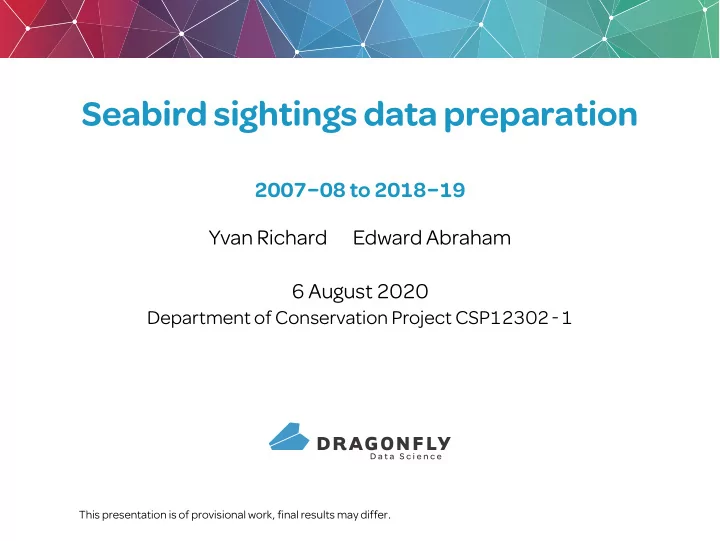

Seabird sightings data preparation 2007–08 to 2018–19 Yvan Richard Edward Abraham 6 August 2020 Department of Conservation Project CSP12302-1 This presentation is of provisional work, final results may differ.
Introduction 2 / 35
Seabirds distributions Introduction • Fundamental for many analyses, e.g., • Seabird risk assessment • Important Bird Areas (IBAs) • Impact assessments • Our knowledge is still very limited • NABIS (mostly expert knowledge) • Low-resolution southern hemisphere maps (Birdlife) 3 / 35
Current knowledge Introduction NABIS 5x5 ◦ from tracking data 4 / 35
Seabird sightings Introduction Two types, treated separately: • Counts of seabirds by observers at the back of fishing vessels • Started in 2003—04 • A dataset never used so far. • Paper forms, started in 2003 • Nomad electronic devices, started in 2009 5 / 35
Paper forms 6 / 35
Seabird sightings Paper forms • Snapshots of seabird abundance by species or species group • Generally following a standard protocol • Trawl: first haul of the day • Longline: all sets and hauls, start, middle, and end of the event • Setnet: at net setting, then every 30 mins during hauling • Data processed by Dragonfly in 2011 • Updated in 2013, with a website made public • Distance information introduced in Oct 2007 7 / 35
Data processing Paper forms Corrections species, and location • Many typos • Reconciliation of species codes and descriptions • Linking to fishing records to get fishing method, target Processing already presented in https://www.dragonfly.co.nz/ publications/abraham_seabirds_2011.html 9 / 35
Data update Paper forms • Counts in last published dataset between 2004 and 2012 • New data up to Nov 2018, provided electronically • Same processing as before • Here, only counts within 100 m of the vessel were kept • Removal of 28% of data, but less confusing 10 / 35
Results Paper forms • 45,325 observations, between Jan 2008 and Nov 2018 • 221,746 counts of seabird species and species groups • 1.2% of zero counts • 91 codes used, of species and species groups • 51% of counts at species or sub-species level 11 / 35
Results Paper forms 12 / 35
Results Paper forms 13 / 35
Nomad electronic devices 14 / 35
Data Nomad electronic devices were considered periods • Use of Nomad handheld devices began in Jan 2009 • Mostly used in inshore fisheries • Initial focus on marine mammals, but only seabird counts • Monitoring of “pods” throughout the day • Counts over time, not snapshots • Zero counts cannot be entered, but derived from on/off duty • No typos, but issues of timings and locations 15 / 35
Processing Nomad electronic devices dataset total count within 1-hour periods • Data transformed to be in a similar format to the paper forms • Snapshots of seabird abundance created at the maximum • Records between civil dusk and dawn were removed • A few examples... 16 / 35
Locations processing Nomad electronic devices Filtering on distance and speed between successive locations, both for the sightings and observer statuses, which are then merged. 21 / 35
Results Nomad electronic devices • 43,609 observations, between Jan 2009 and Oct 2019 • 114,744 counts of seabird species and species groups • 27.8% of zero counts • 72 codes used, of species and species groups • 73% of counts at species or sub-species level 22 / 35
Results Nomad electronic devices 23 / 35
Results Nomad electronic devices 24 / 35
Data exploration 25 / 35
Abundance over time Data exploration Apparent decrease in the recorded number of birds over time 26 / 35
Abundance over time Data exploration The decrease may partially be explained by the proportion of observations in inshore fisheries 27 / 35
Species dominance Data exploration Paper forms Nomad 28 / 35
Website 29 / 35
Data exploration Website • https://seabird-counts.dragonfly.co.nz/?v=1 • Online data exploration tool updated • Abundance map by species group, species, year, or season • Paper forms and Nomad datasets kept separate • Increased resolution from 1 ◦ to 0.4 ◦ • Data download not yet available (MPI RDM approval needed) 30 / 35
Limitations 34 / 35
Limitations Care needed for analysis inshore vs. deepwater • Mistakes in species identification may be present • Use of generic codes may complicate the analysis • Abundance affected by fishing activity, time of day, season, • Different protocol between paper forms and Nomad datasets • Zero counts in Nomad dataset may be inflated 35 / 35
Recommend
More recommend